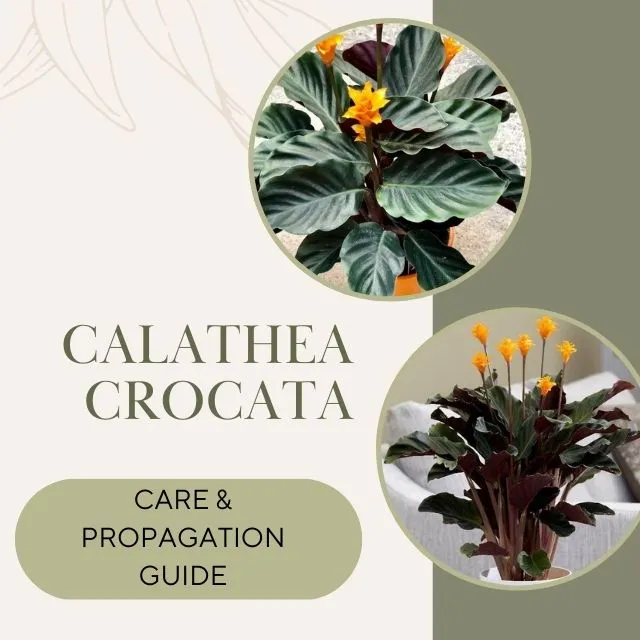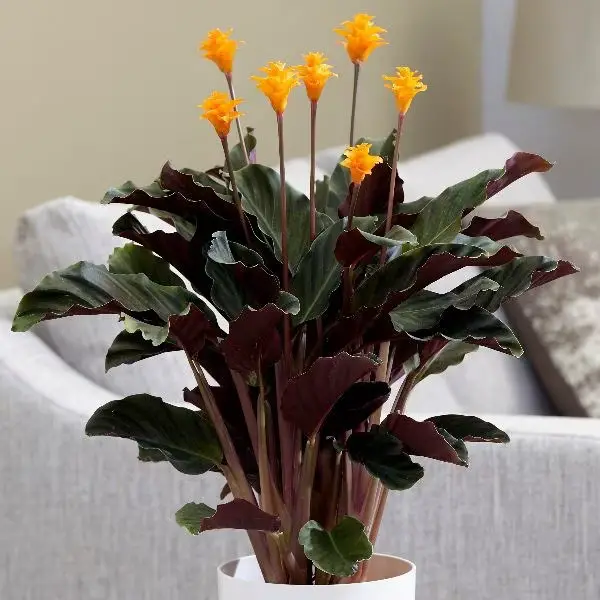Calathea crocata is a species of flowering plant in the Marantaceae family, native to South America, specifically Brazil, Colombia, and Venezuela. It is commonly known as the “eternal flame” or “orange peacock plant” due to its vibrant orange-yellow flowers that resemble flames or peacock feathers.
The plant has large, glossy, green leaves marked with purple undersides, adding to its ornamental appeal. It is an evergreen perennial that grows up to 2 feet tall and thrives in tropical and subtropical environments.
Calathea crocata is a popular houseplant due to its attractive foliage and showy flowers. It prefers moist soil and indirect sunlight, making it an ideal plant for indoor settings. It also has air-purifying qualities, making it a great addition to any home or office.

Characteristics of Calathea Crocata
Calathea crocata is a tropical plant that is prized for its stunning flowers and striking foliage. Here are some of the key characteristics of this plant:
- Flowers: Calathea crocata produces beautiful, brightly colored flowers that are orange-yellow in color and shaped like small cones. The flowers are borne on tall stems that rise above the foliage.
- Foliage: The leaves of Calathea crocata are large, oval-shaped, and have a glossy texture. They are typically green in color with purple undersides, although some varieties may have more pronounced patterns or markings.
- Size: Calathea crocata is a relatively compact plant that grows to a height of around 2 feet (60 cm) and a width of around 1-2 feet (30-60 cm).
- Growing conditions: This plant is native to tropical and subtropical regions and prefers warm, humid environments with indirect sunlight. It requires regular watering and well-draining soil to thrive.
- Air-purifying qualities: Like other plants in the Calathea family, Calathea crocata is known for its air-purifying qualities. It can help to remove pollutants such as formaldehyde and benzene from the air, making it a great choice for indoor environments.
Overall, Calathea crocata is a beautiful and unique plant that adds a touch of tropical flair to any indoor space.
Calathea Crocata Complete Care Guide
Here is a complete care guide for Calathea crocata:
Lighting Requirements
Calathea crocata prefers indirect or filtered sunlight. Avoid placing the plant in direct sunlight, which can scorch its leaves.
Watering Requirements
Keep the soil of your Calathea crocata consistently moist but not waterlogged. Water the plant whenever the top inch of soil feels dry to the touch, and ensure that excess water can drain away from the roots.
Humidity Requirements
Calathea crocata prefers high humidity levels, so consider placing it on a tray of pebbles filled with water or using a humidifier to maintain optimal humidity levels.
Temperature Requirements
Calathea crocata thrives in temperatures between 65-75°F (18-24°C) and should be kept away from cold drafts or hot, dry air.
Soil Requirements
Calathea crocata prefers well-draining soil that is rich in organic matter. A mixture of potting soil, peat moss, and perlite can provide the ideal growing conditions.
Fertilizer Requirements
Calathea crocata benefits from regular fertilization during the growing season (spring and summer). Use a balanced fertilizer at half-strength every two weeks.
Pruning Requirements
Remove any dead or damaged leaves as they occur to prevent them from affecting the plant’s overall health.
By following these care tips, you can keep your Calathea crocata healthy and thriving for years to come.

Propagation of Calathea Crocata
Calathea crocata can be propagated through division. Here’s how to propagate your Calathea crocata:
- Wait until your plant has outgrown its current pot and needs to be repotted. This is the ideal time to propagate.
- Gently remove the plant from its pot, being careful not to damage the roots.
- Gently separate the plant into smaller sections, ensuring each section has roots attached. Use a sharp, clean knife or pruning shears to do this.
- Repot each section in fresh soil. Choose a pot that is slightly larger than the section you are planting. Make a hole in the soil, place the section in the hole, and gently press the soil around it.
- Water the newly propagated sections thoroughly and keep the soil moist until the plant becomes established.
- Place the newly propagated sections in a warm, humid location with bright, indirect light. Avoid direct sunlight, which can scorch the plant’s leaves.
- Keep an eye on your newly propagated Calathea crocata sections and watch for signs of growth. It may take several weeks for the plant to become established, but with proper care, your new plants should begin to thrive.
Propagation by division is the easiest and most reliable method for propagating Calathea crocata. With a little patience and care, you can easily create new plants and expand your Calathea crocata collection.
Common Problems and Solutions
Here are some common problems that can occur when caring for Calathea crocata:
Leaf curling:
If the leaves of your Calathea crocata are curling, it may be due to low humidity levels or insufficient watering.
Increase the humidity around the plant and ensure the soil is consistently moist (but not waterlogged).
Yellowing leaves:
If the leaves of your Calathea crocata are turning yellow, it may be due to overwatering, underwatering, or exposure to direct sunlight.
Adjust your watering schedule and move the plant to a shadier location if necessary.
Brown leaf tips:
Brown leaf tips can be a sign of underwatering, overfertilizing, or exposure to dry air.
Increase your watering schedule, reduce the amount of fertilizer you use, and consider using a humidifier to increase the moisture levels in the air.
Pest infestations:
Calathea crocata is susceptible to pest infestations, such as spider mites and mealybugs.
If you notice any signs of infestation, such as webbing or tiny white bugs, treat the plant with insecticidal soap or neem oil.
Fungal diseases:
Overwatering or poor drainage can lead to fungal infections, such as root rot or leaf spot.
Ensure that the plant’s soil is well-draining and that excess water can drain away from the roots.
Toxicity:
Calathea crocata is not considered toxic to humans or pets, according to the American Society for the Prevention of Cruelty to Animals (ASPCA). However, ingesting any plant material can cause mild stomach upset or digestive issues, so it’s best to keep the plant out of reach of children and pets.
By keeping an eye out for these common problems and taking steps to address them promptly, you can keep your Calathea crocata healthy and thriving.
Conclusion
In conclusion, Calathea crocata is a beautiful and striking plant that is relatively easy to care for with the right conditions. It is native to South America and is known for its vibrant orange flowers and colorful foliage.
To keep your Calathea crocata healthy, provide it with indirect or filtered light, keep the soil consistently moist but not waterlogged, maintain high humidity levels, and fertilize it regularly during the growing season.
Watch out for common problems such as leaf curling, yellowing leaves, brown leaf tips, and pest infestations, and take steps to address them promptly.
By following these care tips and giving your Calathea crocata the love and attention it deserves, you can enjoy this beautiful plant for years.
Also Check:
- Easy Calathea Warscewiczii Care & Propagation for Healthy Growth
- How to Care for Calathea Medallion with Growth Tips
Frequently Asked Questions about Calathea Crocata
Is Calathea crocata a low-light plant?
Calathea crocata prefers bright, indirect light but can tolerate lower light conditions. However, too little light may result in slower growth and less vibrant colors.
How often should I water my Calathea crocata?
Water your Calathea crocata when the top inch of soil feels dry. It’s important not to let the soil dry out completely but also avoid overwatering as this can lead to root rot.
Can Calathea crocata be grown outdoors?
Calathea crocata is a tropical plant that is best grown indoors, where it can be protected from cold temperatures and direct sunlight.
How often should I fertilize my Calathea crocata?
Fertilize your Calathea crocata once a month during the growing season (spring and summer) with a balanced, water-soluble fertilizer.
How do I increase humidity around my Calathea crocata?
You can increase humidity around your Calathea crocata by placing a tray of water near the plant, misting the leaves regularly, or using a humidifier. You can also group several plants together to create a more humid microclimate.
Can Calathea crocata be propagated through stem cuttings?
No, Calathea crocata cannot be propagated through stem cuttings. The plant is propagated through division, which involves separating the plant into smaller sections with roots attached
